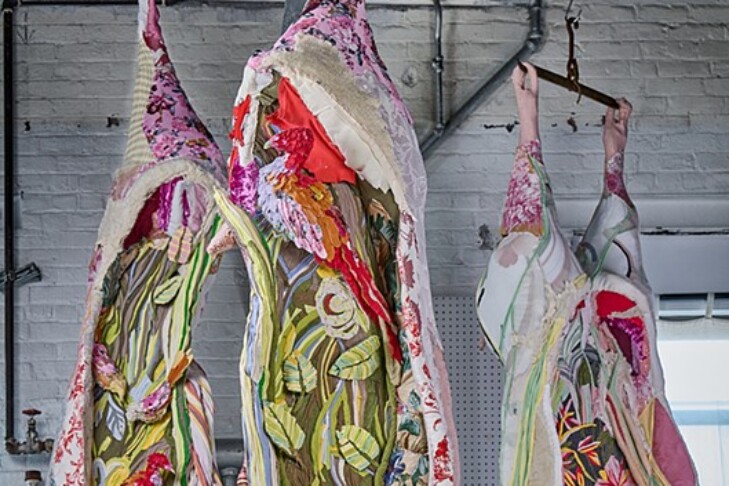Art d’var: Commentary on Torah through a related work of art. Just as Torah is a framework for Jewish life that must be unpacked and investigated from many angles to understand the depth of its content and applicability to our own lives, so is great art. This series illuminates works of art that help contemporize the ancient text of the Torah.
Shemini
26th weekly Torah Portion
4,670 Hebrew letters
1,238 Hebrew words
91 verses
Shemini, meaning “eight” in Hebrew, is the Torah portion where God instructs Moses and his brother, Aaron, on the rules of kashrut through the famous line, “Any animal that has true hoofs, with clefts through the hoofs, and that chews the cud—such you may eat” (Leviticus 11:3).
This line fascinates me because it is typically known by even the “least religious” of Jewish people. Kashrut is a ubiquitous symbol of Jewish life, and rightfully so because food and eating impact everything.
And while I choose not to keep kosher in my own practice, these rules of kashrut serve as a reminder to me of the value of the lives of the animals who give me sustenance.
When I think of a visual representation of how we value the lives of the animals we eat, I immediately think of the work of Argentinian Israeli-born artist Tamara Kostianovsky.
I first came across Tamara’s work in a small bright-white gallery at the Fuller Craft Museum in Brockton, a relatively unlikely place to find innovative Israeli work. I was immediately entranced by the striking life-sized quilted fabric recreations of slabs of meat, red and sinewy, hanging from the walls and ceiling of the gallery, slowly rotating to feature the intricately detailed 3D elements.
In this series, called “Tropical Abattoir,” Tamara brings you into her butcher shop with vibrantly multicolored meat carcasses. From a distance, you would swear you were looking into a real butcher’s windows, but as you approach the work, you see colors and textures that take these pieces from slabs of meat to elaborate, sacred and beautiful works of art, created from upcycled fabric.
Tamara’s focus on meat and the importance of upcycling materials in her work is heavily inspired by her childhood in Argentina, where the meat industry is famous. She is also inspired by her birth country of Israel, recognizing that most meat in Israel is kosher and has been slaughtered and treated in such a specific way.
In her artist statement, Tamara says: “The discovery of a world concealed behind the skin took form in my adolescence while working at a surgeon’s office, where veins exploded into waterfalls, cut ligaments set free the muscles they once contained, and chunks of fat poured over tissues of various colors and textures. A fascination with these encounters put the body at the center of my work.”
Garments from my own wardrobe make up the bulk of the material I use in my fabric work. Committed to giving a second chance in the world to rejected articles of clothing and other domestic textile items, I periodically cannibalize my own wardrobe looking to find supplies to create sculptures with. By contrasting a visceral imagery with soft materials, I seek to reintegrate the physicality of our bodies and the natural processes of birth, growth and decay back into our existential understanding of life.
It’s through this combination of fascination with the human body and muscle, the influence of the Argentinian meat culture and her obsession with upcycling materials to give beautiful new life to old materials that, for me, really illustrates the meaning of kashrut.
When I stand amongst the “Tropical Abattoir” pieces, I’m reminded of the holiness of animal lives and our ecosystem that makes it possible for us humans to have such easy access to meat. The eerie combination of gory and gorgeous work draws you in and pushes you to question your own relationship with meat and eating animals
Through Tamara’s work, I am reminded to be grateful for the animals and food that I eat, and isn’t that the ultimate meaning of kashrut?
This post has been contributed by a third party. The opinions, facts and any media content are presented solely by the author, and JewishBoston assumes no responsibility for them. Want to add your voice to the conversation? Publish your own post here. MORE



